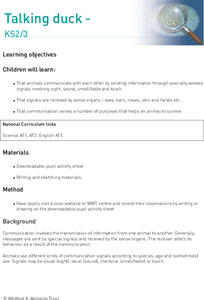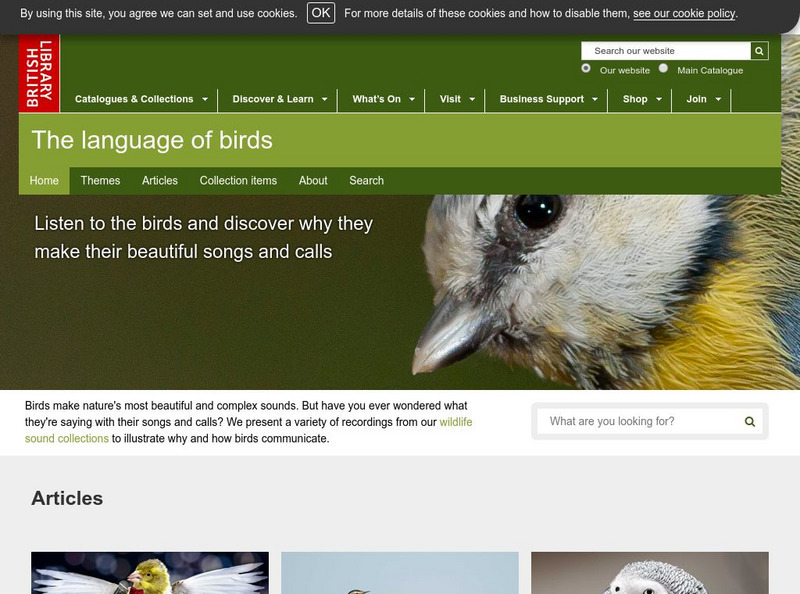TED-Ed
How to Speak Monkey: The Language of Cotton-Top Tamarins
Tamarin monkey language can be categorized by stem upsweep, duration, peak frequency, and frequency change. Although other complex terminology is used to describe the 38 calls of this species, the video is easy to follow and a...
Curated OER
Talking Duck
Students study how animals communicate through their senses and signals. They investigate how animals survive using their communication skills and create a commercial based on the research.
Curated OER
Animal Language Play
Review animal behavior and forms of language. Types of communication are listed along with their messages. The majority of slides consist of humorous internet images (i.e. "I Can Has Cheezburger" cats).
Curated OER
Sound Off!
Students investigate the sounds animals make as they communicate. In this animal communication lesson, students play a game in which they simulate animal sounds. They attempt to find their animal partner before being captured by a predator.
Curated OER
Talking Duck
Students visit a local wetland or WWT centre and record their observations by writing or drawing on the downloadable pupil activity sheet.
Curated OER
Animal Communication
Students use three nonfiction selections in order to investigate the concept of animal communication. They use a graphic organizer for the information as it is gathered in the reading.
Curated OER
Animals and Humans Say the Darnedest Things
Students explore and analyze human and animal communications and create a short film that illustrates their findings.
British Library
British Library: Listen to Nature: The Language of Birds
Have you ever wondered why birds sing or how they communicate? The Language of Birds explains the hows and whys.
DOGO Media
Dogo News: Quest to Seek Out "World's Loneliest Whale"
Read how scientists are working to track a whale who sings at a pitch too high to be heard by other whales, which has resulted in it being named the "World's Loneliest Whale." Includes video.
Other
Nature Soundmap
A group of professional nature recordists from around the globe have collaborated to develop Nature Soundmap, an enjoyable and interactive way of exploring the natural sounds of our planet. Use Nature Soundmap to discover the wonderful...
Mind My Education
Mind My Education: The Life of Environments
This extensive lesson plan covers various topics about how animals interact with their environment. Topics include how animals sense their environment, how environments and organisms change together, and how animals use their senses to...
University of Florida
Florida Museum of Natural History: Animals 1: Fur, Fins, Feathers, and More
This teacher's guide focuses on familiar animals such as mammals, birds, reptiles, amphibians, and fish.
ArtsNow
Arts Now Learning: Magic Rocks [Pdf]
In this lesson, students work in groups with each acting as a predator, prey, or family member in a particular habitat. They present their habitat performance to the class and students identify the habitat and animal relationships. Then,...
TED Talks
Ted: Ted Ed: Why Do Whales Sing?
Stephanie Sardelis decodes the evocative melodies composed by the world's largest mammals, whales. [5:12]
TED Talks
Ted: Ted Ed: How to Speak Monkey: The Language of Cotton Top Tamarins
Anne Savage teaches a few cotton-top tamarin chirps and calls, taking us through a day in the life of Shakira the tamarin as Shakira signals to her family, talks to her food and warns against potential predators. [5:14]
TED Talks
Ted: Ted Ed: Do Animals Have Language?
All animals communicate. But do they have language? Michele Bishop details the four specific qualities we associate with language and investigates whether or not certain animals utilize some or all of those qualities to communicate. [4:55]
TED Talks
Ted: Ted Ed: How Do Dogs See With Their Noses?
You may have heard the expression that dogs 'see with their noses.' But these creature's amazing nasal architecture actually reveals a whole world beyond what we can see. Alexandra Horowitz illustrates how the dog's nose can smell the...
Other
English to Go: "Animal Apps"
An article about the US and Canadian zoos using apps to teach apes is a springboard for this creative activity. Pre-reading questions, the article from Reuters, and follow-up summary in addition to grammar exercises make up a complete...
Scientific American
Scientific American: Dogs Process Language Like Us, but What Do They Understand?
Can dogs actually understand what people say to them? Is it the tone or the words they process?
Other
Elephant Voices: Ele Quiz
Three interactive quizzes on the topics of elephant families, getures, and vocal communication. After each ten-question quiz, the correct answers are shown for review.
American Museum of Natural History
American Museum of Natural History: Communication O Logy Card
Turn over this interactive OLogy card and start learning bite-size pieces of useful information about how animals communicate.
Read Works
Read Works: Do Animals Have Feelings?
[Free Registration/Login Required] An informational text debating whether or not animals feel various emotions. A question sheet is available to help students build skills in reading comprehension.
CK-12 Foundation
Ck 12: Life Science: Animal Communication
[Free Registration/Login may be required to access all resource tools.] What does the word "communication" make you think of? Talking on a cell phone? Texting? Writing? Those are just a few of the ways in which human beings communicate....
CommonLit
Common Lit: How Human Should a Gorilla Be?
A learning module that begins with "How Human Should a Gorilla Be?" by Barbara J. King, accompanied by guided reading questions, assessment questions, and discussion questions. The text can be printed as a PDF or assigned online through...























